In the world of wedding florals, the peony stands out for its lush, layered petals and rich hues, often symbolizing prosperity and good fortune. This bloom, with its enchanting sweet fragrance, graces wedding arrangements primarily from April to June, offering a limited yet impactful bloom period. Its versatility spans from bouquets to centerpieces, effortlessly harmonizing with diverse wedding themes. As we explore the physical attributes, color varieties, and cultural significance, one can appreciate why the peony remains a quintessential choice for couples seeking elegance and meaning on their special day.
Flower Overview
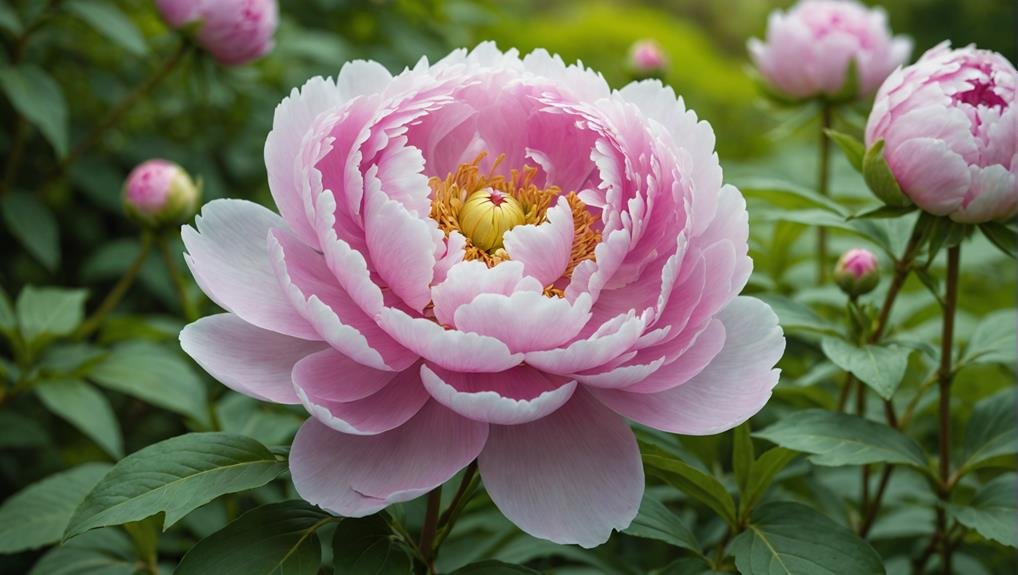
Peonies are perennial flowers celebrated for their large, cupped petals and vibrant colors, making them a favored choice for both home gardens and wedding arrangements. The Peony flower, with its striking appearance, is known for its wide array of hues, ranging from whites and light pinks to coral pinks, fuchsias, purples, reds, and even yellows.
This extensive color palette allows for flexibility in matching various wedding themes and color schemes, making peonies one of the most popular wedding flowers. Their elegance and versatility contribute to their popularity in wedding bouquets, centerpieces, and other floral decorations.
The lush, full blooms of peony flowers not only add a touch of sophistication to wedding arrangements but also blend seamlessly with other floral varieties, enhancing the overall aesthetic of the event. Despite their beauty, peonies are among the more expensive wedding flowers, with costs influenced by factors such as sourcing and seasonality.
Typically blooming from April to June, their availability is limited, which can further impact their price. Nonetheless, their timeless appeal and the luxurious ambiance they create continue to make peonies a top choice for weddings.
Physical Description
Characterized by their large, cupped petals and vibrant, showy blooms, these flowers exude a sweet fragrance and are often seen as symbols of good fortune, prosperity, and happiness. Peonies are renowned for their striking appearance and aromatic presence, making them a staple in wedding bouquets and floral arrangements. Their petals can be found in a range of colors, including white, pink, red, and yellow, which allows for versatile design choices that can suit various wedding themes and styles.
Peonies have narrow, elongated leaves and thornless stems, which are particularly advantageous for florists and gardeners. This unique combination of aesthetic beauty and practical features contributes to their widespread popularity. Their bloom period spans from April to June, with each flower typically lasting about a week. This limited bloom time coincides perfectly with the peak wedding season, further cementing their status as a favorite among brides and wedding planners.
Key features of peonies include:
- Large, cupped petals
- Sweet fragrance
- Narrow, elongated leaves
- Thornless stems
These attributes not only enhance the visual appeal of wedding bouquets but also imbue them with symbolic meanings of joy and prosperity, making peonies an ideal choice for such special occasions.
Available Colour Varieties
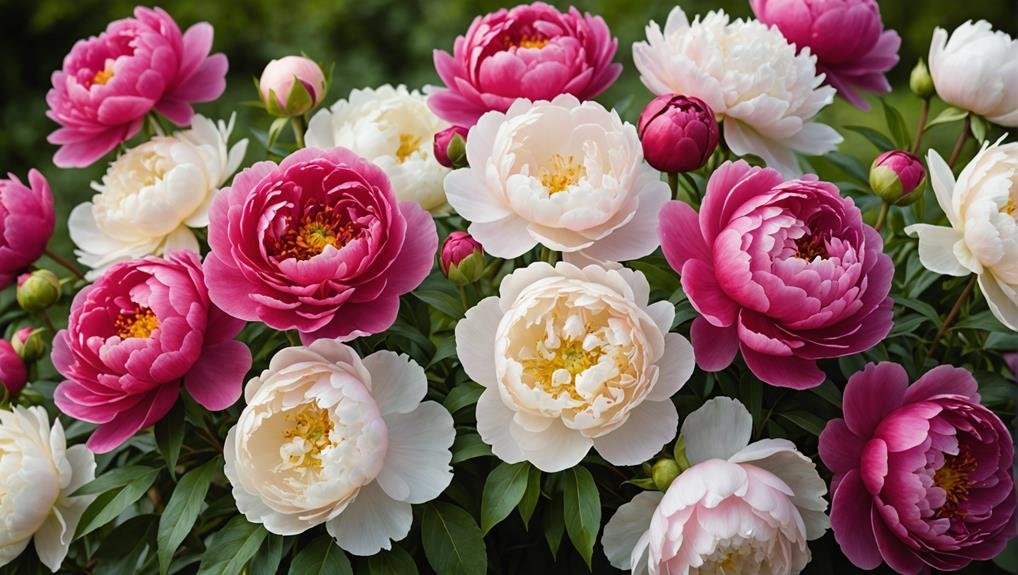
Among the many appealing aspects of peonies is their availability in a wide range of colors, including white, light pink, coral pink, fuchsia, purple, red, and yellow. White peonies convey a sense of elegance and purity, making them ideal for traditional wedding themes.
Light pink peonies offer a soft, romantic touch, while coral peonies introduce a vibrant, warm hue that can brighten any bouquet. For those seeking a bolder statement, red peonies provide a rich, passionate color choice.
In addition to these classic shades, fuchsia and purple sweet peas can be incorporated for a more diverse and striking arrangement. Although not traditional peony colors, purple sweet peas complement peonies beautifully, adding depth and contrast.
Meanwhile, bright yellow peonies can infuse a cheerful and sunny vibe into wedding decor, standing out with their vivid hue and bright yellow stamens that create a captivating focal point.
The versatility of mixing and matching these color varieties allows brides and wedding planners to craft unique and personalized floral arrangements. This extensive color palette ensures that peonies can seamlessly integrate into any wedding theme, from classic elegance to contemporary vibrancy.
Latin Name and Taxonomy
The Latin name for the peony is Paeonia, placing it within the family Paeoniaceae. This family encompasses numerous species known for their striking, showy blooms and significant horticultural value. Peonies are mostly herbaceous perennials, although some species are woody shrubs. The taxonomy of Paeonia includes several species such as Paeonia lactiflora, Paeonia officinalis, and Paeonia suffruticosa, each distinguished by unique characteristics.
Peonies exhibit a wide range of traits that make them highly sought after for wedding arrangements and garden displays:
- Flower color: Peonies come in a range of colors, from pure white to deep red, offering versatile options for various aesthetics.
- Leaf structure: The leaves of peonies vary in shape, providing additional texture and visual interest to their overall appearance.
- Showy blooms: The large, lush blooms of peonies are a key highlight, often serving as focal points in floral arrangements.
- Herbaceous perennials: Most peonies die back to the ground in winter and re-emerge in spring, making them a reliable choice for gardeners.
Understanding the taxonomy of Paeonia helps in selecting the right species and varieties for specific purposes, ensuring that their beauty is maximized in any setting.
Geographical Origins
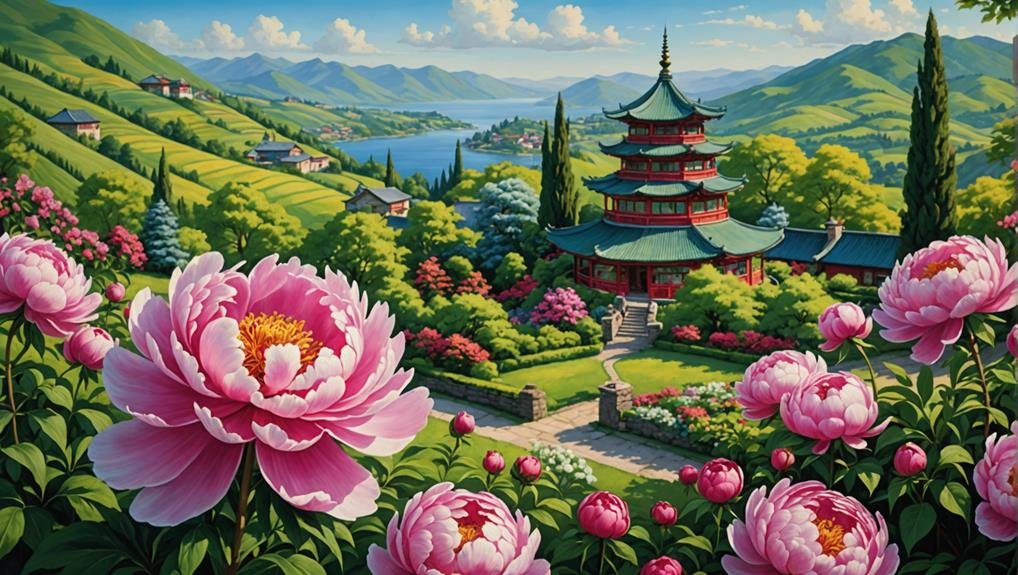
Originating from diverse regions across Asia, Europe, and North America, peonies boast a rich geographical heritage. These elegant blooms have been cultivated for centuries, with their native habitats spanning various continents. Among the principal countries known for peony cultivation are China, Japan, and the United States.
China holds the title of the largest producer of peonies, where they are deeply woven into the cultural and historical fabric. Japan, likewise, has a long-standing tradition of growing peonies, often symbolizing prosperity and honor. In the United States, peonies are extensively grown, with notable peony farms in the state of Alaska. The cooler regions of Alaska provide an ideal environment for peony cultivation, allowing these flowers to thrive even in colder climates.
Peonies are well-suited to temperate climates, making them popular in regions that experience moderate weather conditions. Their ability to flourish in colder regions underscores their resilience and adaptability, further contributing to their widespread appeal.
Here is a quick overview of key regions associated with peony cultivation:
| Country | Notable Region |
|---|---|
| China | Various provinces |
| Japan | Local gardens and farms |
| United States | Alaska |
| Europe | Various temperate areas |
This geographical diversity underscores the peony’s enduring allure across different cultures and climates.
Season Availability
Seasonal presence of peonies greatly influences their popularity and pricing for weddings and special events. Blooming from April to June, peonies are considered a quintessential spring and early summer flower. Their peak availability in May makes this period ideal for obtaining these blooms at their freshest and most affordable.
The seasonal nature of peonies means that their availability and pricing vary substantially throughout the year. During their natural blooming season, local sourcing can help lower costs and ensure flowers of best freshness. Conversely, obtaining peonies outside their peak season often involves significant importing and logistical challenges, leading to higher prices.
- Blooms from April to June
- Peak availability in May
- Local sourcing reduces costs
- Higher prices outside peak season
The high demand for peonies, particularly for weddings and special events, further impacts their pricing. When in season, their lush and romantic appearance makes them a favorite among brides and event planners. However, due to their limited availability during other times of the year, flowers may command premium prices, affecting overall budget considerations for floral arrangements.
Growing Conditions
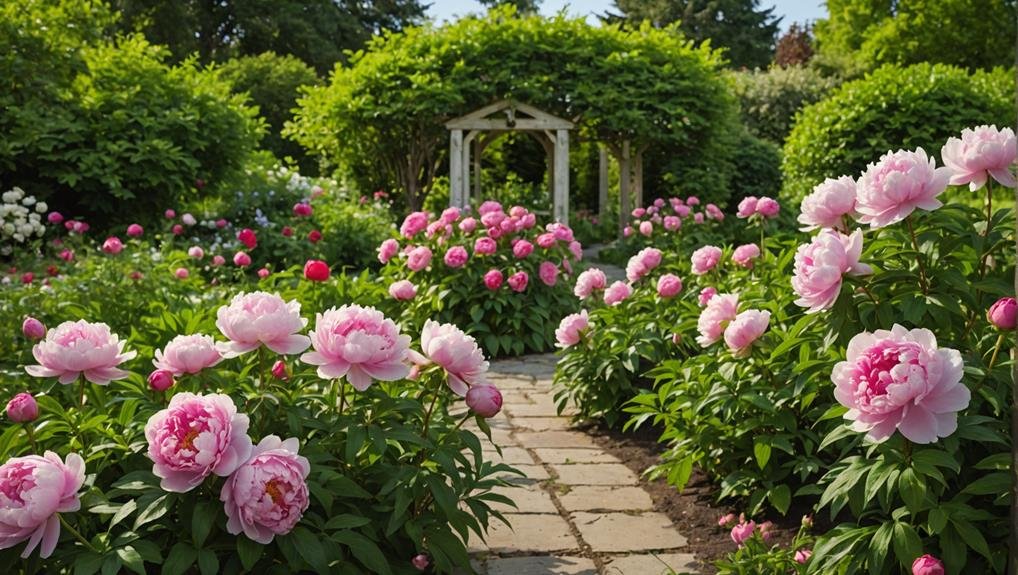
Peonies thrive most under full sunlight to partial shade conditions, needing well-drained, rich soil for optimal growth. These beautiful flowers flourish in environments where they can receive abundant sunlight, although they can tolerate partial shade, especially in hotter climates. Ensuring the soil is both rich and well-drained is essential, as peonies do not do well in waterlogged conditions.
Consistent watering is vital, especially during periods of drought or high temperatures. However, it is important to avoid excessive watering, which can result in root rot. Peonies should ideally be planted in the autumn, allowing their roots to establish before the spring growing season. This timing maximizes their potential for strong blooms.
Peonies are resilient across USDA zones 3-8, making them suitable for a wide range of climates. By following these growth conditions, gardeners can guarantee healthy and colorful peony plants, ideal for any wedding arrangement.
Cultural Significance
Across various cultures, the peony holds profound symbolic meaning, often representing prosperity, honor, and good fortune. This flower’s rich cultural symbolism spans continents and traditions, making it a cherished choice for numerous ceremonies and celebrations.
In Chinese tradition, peonies are highly regarded as symbols of prosperity, honor, and good fortune. They are often featured in art and literature, embodying the ideal of a flourishing life.
Similarly, in Japan, peonies are revered as the ‘king of flowers’ and are associated with bravery, honor, and good fortune, reflecting their esteemed status in Japanese culture.
Western interpretations of the peony also highlight its romantic and auspicious connotations. Here, peonies symbolize:
- Romance and love
- Prosperity and a happy marriage
- Compassion and long-lasting union
- Honor and good fortune
These attributes make the peony a popular flower for weddings and other significant life events, where its presence is believed to bring blessings and positive energy.
Universally valued for its beauty and positive symbolism, the peony continues to be an enduring symbol of love, prosperity, and honor across different cultures, underscoring its timeless appeal and significance.
Typical Use in Weddings
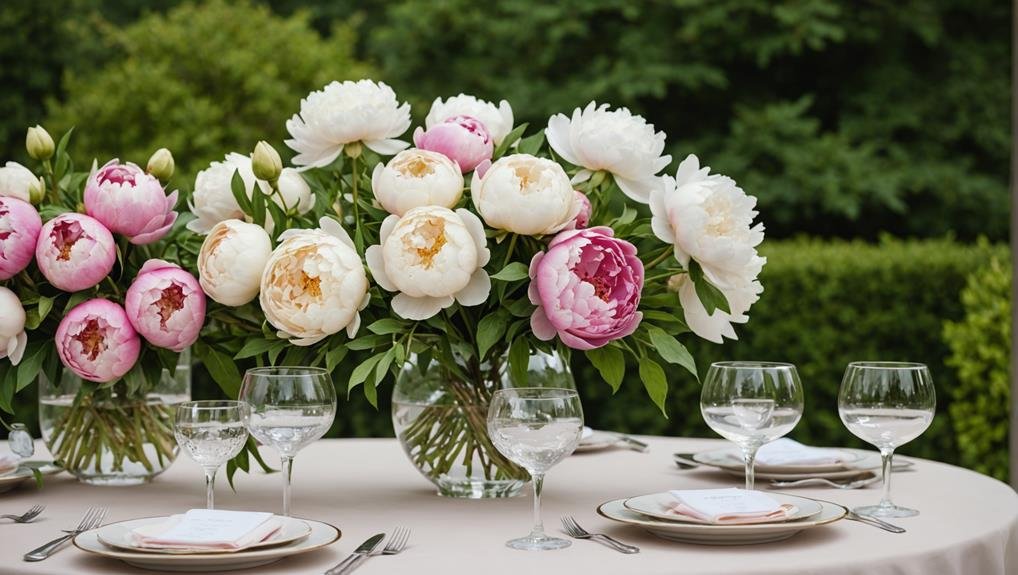
The profound cultural significance of peonies naturally extends into their typical use in weddings, where they are celebrated for their symbolic representation of good fortune, prosperity, and a happy marriage. These exquisite blooms are a popular choice for bridal bouquets, Bridesmaid Bouquets, centerpieces, and other wedding decor elements. Their lush petals and delicate fragrance add a touch of elegance to any wedding theme, making them a versatile option for enhancing the overall aesthetic.
Peonies are available in a wide range of colors, allowing them to seamlessly blend with various color schemes. Whether aiming for a classic white and blush palette or a vibrant mix of hues, peonies can be tailored to match the desired floral design. Brides often opt for a pastel bouquet to complement their wedding theme, creating a harmonious and visually appealing look.
Below is a table showcasing the emotional impact of using peonies in different aspects of wedding decor:
| Element | Emotional Impact |
|---|---|
| Bridal Bouquet | Elegance and Romance |
| Bridesmaid Bouquets | Cohesion and Beauty |
| Centerpieces | Warmth and Charm |
| Ceremony Backdrop | Grandeur and Sophistication |
| Reception Decor | Joy and Festivity |
Alternative Flower Types
When considering alternatives to peonies for wedding floral arrangements, garden roses, ranunculus, and dahlias offer similarly lush and romantic aesthetics. These flowers can seamlessly replace peonies while providing the same level of elegance and visual appeal.
Garden roses, with their full blooms and delicate petals, mimic the opulence of peonies. Ranunculus brings a similar texture and richness, making them an excellent choice for wedding bouquets and centerpieces. Dahlias, known for their intricate layers, add depth and sophistication to any arrangement.
For those seeking more budget-friendly options without sacrificing beauty, lisianthus, hydrangeas, and carnations are ideal substitutes. Hydrangeas, with their voluminous clusters, create a sense of abundance, while lisianthus and carnations offer versatility and charm.
Additionally, anemones provide a unique touch with their striking centers and delicate petals.
- Garden roses: Offer a lush and romantic look.
- Ranunculus: Provide texture and richness.
- Dahlias: Add depth and sophistication.
- Lisianthus, hydrangeas, and carnations: Budget-friendly and beautiful.
